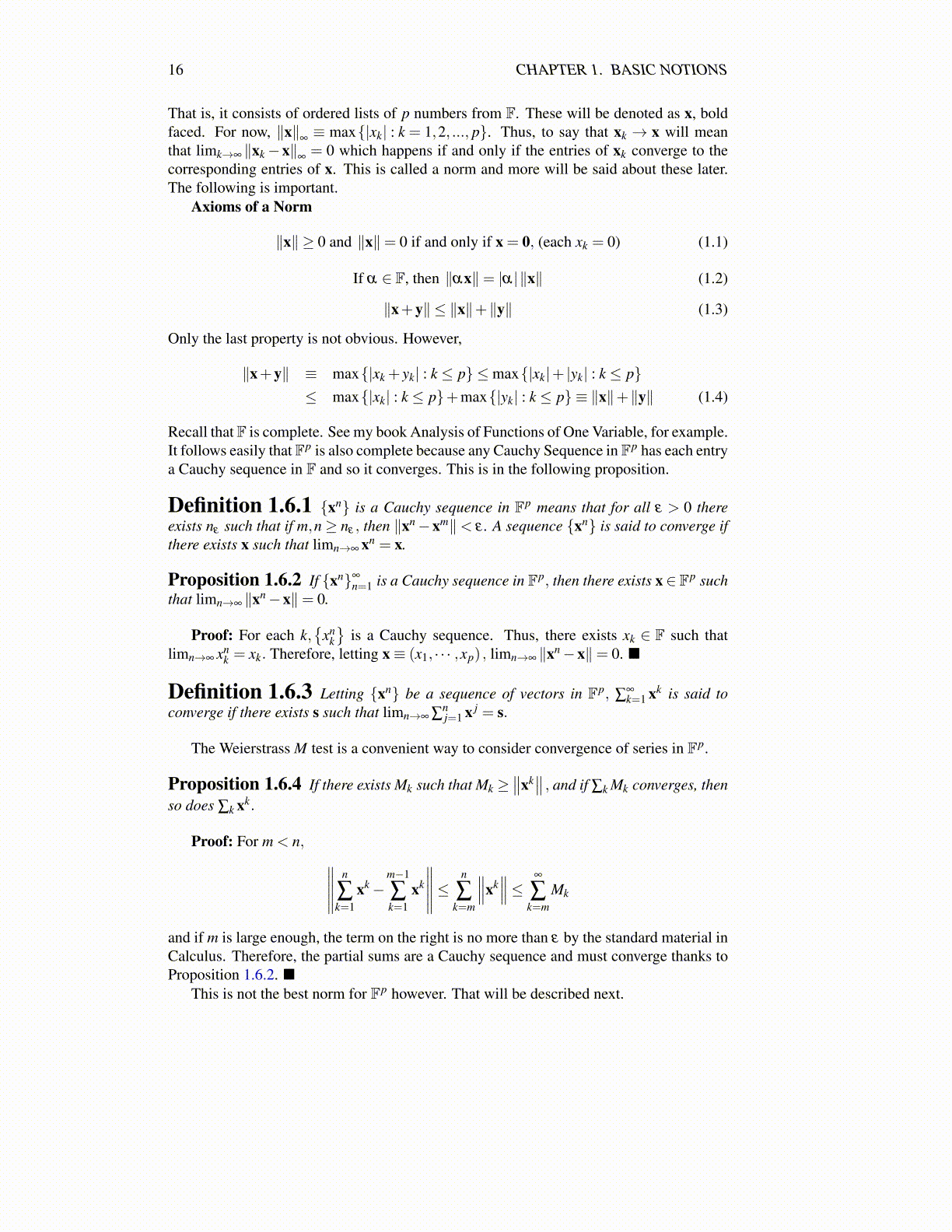
16 CHAPTER 1. BASIC NOTIONS
That is, it consists of ordered lists of p numbers from F. These will be denoted as x, boldfaced. For now, ∥x∥
∞≡ max{|xk| : k = 1,2, ..., p}. Thus, to say that xk → x will mean
that limk→∞ ∥xk−x∥∞= 0 which happens if and only if the entries of xk converge to the
corresponding entries of x. This is called a norm and more will be said about these later.The following is important.
Axioms of a Norm
∥x∥ ≥ 0 and ∥x∥= 0 if and only if x = 0, (each xk = 0) (1.1)
If α ∈ F, then ∥αx∥= |α|∥x∥ (1.2)
∥x+y∥ ≤ ∥x∥+∥y∥ (1.3)
Only the last property is not obvious. However,
∥x+y∥ ≡ max{|xk + yk| : k ≤ p} ≤max{|xk|+ |yk| : k ≤ p}≤ max{|xk| : k ≤ p}+max{|yk| : k ≤ p} ≡ ∥x∥+∥y∥ (1.4)
Recall that F is complete. See my book Analysis of Functions of One Variable, for example.It follows easily that Fp is also complete because any Cauchy Sequence in Fp has each entrya Cauchy sequence in F and so it converges. This is in the following proposition.
Definition 1.6.1 {xn} is a Cauchy sequence in Fp means that for all ε > 0 thereexists nε such that if m,n≥ nε , then ∥xn−xm∥< ε . A sequence {xn} is said to converge ifthere exists x such that limn→∞ xn = x.
Proposition 1.6.2 If {xn}∞
n=1 is a Cauchy sequence in Fp, then there exists x∈ Fp suchthat limn→∞ ∥xn−x∥= 0.
Proof: For each k,{
xnk
}is a Cauchy sequence. Thus, there exists xk ∈ F such that
limn→∞ xnk = xk. Therefore, letting x≡ (x1, · · · ,xp) , limn→∞ ∥xn−x∥= 0. ■
Definition 1.6.3 Letting {xn} be a sequence of vectors in Fp, ∑∞k=1 xk is said to
converge if there exists s such that limn→∞ ∑nj=1 x j = s.
The Weierstrass M test is a convenient way to consider convergence of series in Fp.
Proposition 1.6.4 If there exists Mk such that Mk ≥∥∥xk∥∥ , and if ∑k Mk converges, then
so does ∑k xk.
Proof: For m < n, ∥∥∥∥∥ n
∑k=1
xk−m−1
∑k=1
xk
∥∥∥∥∥≤ n
∑k=m
∥∥∥xk∥∥∥≤ ∞
∑k=m
Mk
and if m is large enough, the term on the right is no more than ε by the standard material inCalculus. Therefore, the partial sums are a Cauchy sequence and must converge thanks toProposition 1.6.2. ■
This is not the best norm for Fp however. That will be described next.